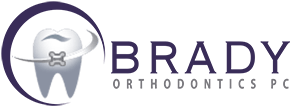Headgear | MARA | Lower Lingual Arch | Nance Appliance | Distal Jet Appliance | Pendulum Appliance | Thumb/Finger Appliance | Lip Bumper | Tongue Thrusting Appliance
Headgear
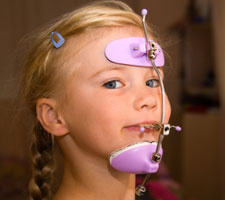
Headgear is often used to correct an excessive overbite. This is done by placing pressure against the upper teeth and jaw, which would hold the teeth in position or help move them into better positions. The severity of the problem determines the length of time headgear needs to be worn. The key to success with your headgear appliance is consistency. Headgear must be worn a certain number of hours per day, and if not, it must be made up the following day.
Headgear should never be worn while playing sports and should also be removed while eating or brushing your teeth.
MARA
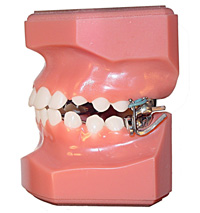
The Mandibular Anterior Repositioning Appliance (MARA) is suitable for treating class II malocclusions, which are characterized by protrusion of the upper front teeth or a lower jaw and or teeth that are positioned back in regard to the upper jaw and or teeth. Using MARA, class II malocclusions are treated more effectively. The MARA is reliable and reduces treatment time.
Generally, the appliance is secured to the patient's first molars via stainless steel crowns, which are easy to fit and retain more, compared to bands. The appliance features no removable parts, which means patient compliance is not an issue. Also, the orthodontist can more accurately predict the length of treatment.
The upper "elbows" can be removed; which facilitates comfort and advanced adjustments. The appliance can be advanced on one side or both sides.
Sore spots are minimal. Initially, it may feel strange to hold your jaw forward while eating, but within two weeks, chewing will become more natural. We recommend you eat soft foods initially. Do not chew on the elbows. Avoiding candy, hard foods, etc. throughout treatment will help prevent breakage of the appliance.
MARA is generally worn between 15 to 18 months. Your improvements will be noticed immediately!
Lower Lingual Arch
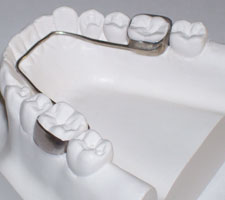
A Lower Lingual Arch acts as a space maintainer to keep the molars from drifting forward, and prevent them from blocking the space where permanent teeth will eventually erupt. This appliance is commonly used in cases of premature loss of baby tooth or when the lower teeth of a growing child are slightly crowded and no permanent teeth are extracted to correct the problem.
You should expect soreness the first day or two, and it may hurt to chew. We recommend a soft diet initially. You may take Advil or Tylenol to relieve the pain. Avoid sticky or hard foods, and please monitor how many foods you eat that are high in sugar.
Brushing and flossing daily is very important. Be sure to clean around the bands that are connected to the molars and the wire on the tongue side. This will prevent the formation of cavities or infection of the gums.
The duration of wear varies. We will monitor the eruption of new teeth and make adjustments. Generally, the Lower Lingual Arch is removed following the eruption of all the permanent teeth.
Nance Appliance
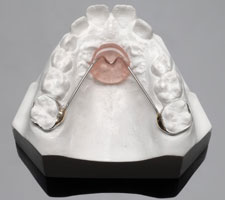
The Nance Appliance is used to prevent upper molars from rotating or moving forward after you've worn a headgear, a Wilson's arch or any other appliance to move your molars back. Some patients wear the Nance Appliance while they are awaiting their bicuspids to grow into place.
The appliance is made of two bands that are cemented onto the first molars and a wire spans the roof of the mouth from one molar to the other. An acrylic pad or "button" covers the wire that touches the roof of your mouth directly behind your front teeth.
Patients should always brush around the bands daily. Do not eat sticky, chewy candy as it can loosen your appliance.
Distal Jet Appliance
The Distal Jet Appliance is a non-removable lingual appliance that is used to move upper teeth backward faster and more predictably than headgear. The Distal Jet distalizes molars and corrects teeth that have rotated. This appliance corrects class II problems.
The Distal Jet Appliance uses a solid track wire and two sets of locking screws on each side. The appliance is self-limiting by design because it has a distal stop attached to the tracking wire. The Distal Jet can be converted to a Nance Appliance by tightening the distal and anterior locks against the track wire and adding a Nance holding arch.
Pendulum Appliance
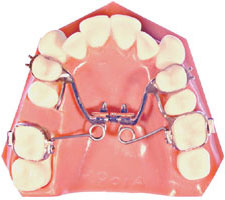
The Pendulum Appliance is used to correct class II malocclusions by distalizing upper molars. It's used to correct the patient's bite on the side of their mouth.
The Pendulum Appliance consists of a plastic "button" that touches the roof of the mouth and resilient wire springs that act in a broad swinging arc to move the molars back. The appliance uses the roof of the mouth as an anchor to move the molars back into their correct positions. Patients usually wear this appliance for 3 to 5 months.
Thumb/Finger Appliance
Sucking is a natural reflex that relaxes and comforts babies and toddlers. Children usually cease thumb sucking when the permanent front teeth are ready to erupt. Typically, children stop between the ages of 2 and 4 years. Thumb sucking that persists beyond the eruption of primary teeth can cause improper growth of the mouth and misalignment of the teeth. If you notice prolonged and/or vigorous thumb sucking behavior in your child, talk to your dentist.
One solution to thumb sucking is an appliance called a "fixed palatal crib." This appliance is put on the child's upper teeth by an orthodontist. It's placed behind on the upper teeth on the roof of the mouth. The crib consists of semicircular stainless steel wires that are fastened to molars using steel bands. The stainless steel wires fit behind the child's upper front teeth, and they are barely visible. The crib usually stops the habit of thumb sucking within the first day of use.
Lip Bumpers
We like to avoid pulling teeth as often as possible, so we use lip bumpers on our patients who need to create more room for their crowded teeth. The lip bumper is a wire on the lower jaw that extends from one molar to another and keeps lips and cheeks from touching your teeth. When you move your mouth or speak, your lips and cheeks push on the bumper, and the bumper applies pressure to the teeth. This pressure pushes the molars back, creating more space for overcrowded teeth.
If you have a lip bumper, please remember to leave it in while eating, but do not eat hard or sticky foods. Proper, thorough brushing should remove any food that gets stuck in your lip bumper.
Tongue Thrusting Appliance
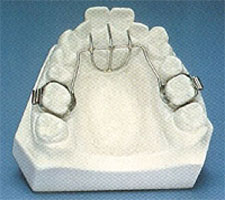
Tongue thrusting occurs when the patient presses his or her tongue against the front teeth, usually when swallowing, speaking or resting the tongue. If thrusting is constant, this can cause problems with teeth alignment and must be fixed.
We prefer to correct tongue thrusting by giving patients a tongue thrusting appliance. This appliance, similar to a mouth guard, is usually worn at night. Other times, a more permanent appliance is prescribed and can be only be adjusted by our office.
